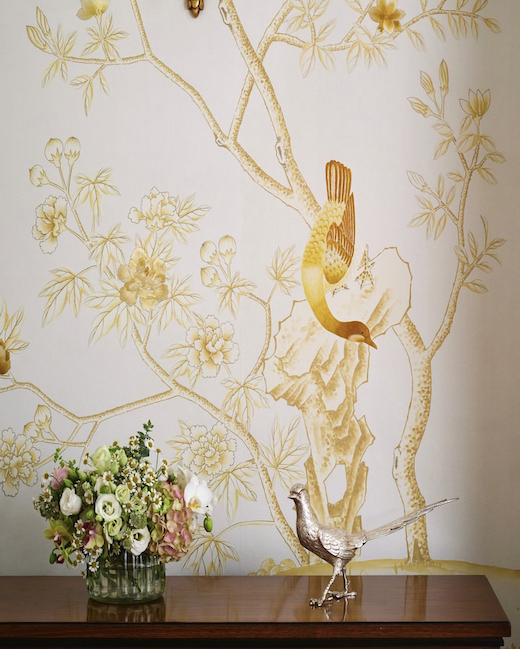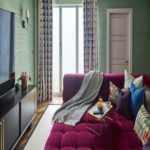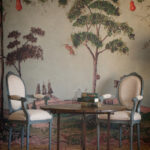10 Most-Googled Wallpaper Questions, Answered By Experts
Here are the most-Googled questions when it comes to wallpaper, with answers from the experts at Wells Interiors.
#1 How to remove wallpaper?
When it comes to removing wallpaper, it’s essential to be cautious because damage to the walls could arise if the process is not done carefully. Wallpaper removal can be a tricky task, and if not done correctly, it can result in wall damage such as gouges, scratches, or even structural issues. Common issues that can arise during DIY wallpaper removal include:
Wallpaper Residue: Leftover adhesive or bits of wallpaper can be challenging to remove, making it difficult to prepare the surface for new paint or wallpaper.
Wallboard Damage: Overly aggressive scraping or excessive moisture can damage the underlying drywall or plaster, which may require repairs.
Drywall Seam Damage: Excessive moisture or scraping near seams and corners can cause damage to the drywall or joint compound.
Patching and Repairs: Removing wallpaper may reveal existing imperfections in the wall that need to be patched and repaired before painting or applying new wallpaper.
For these reasons, (we’ve said it before and we will say it again) we strongly suggest you seek the help of a professional. Professionals have the experience and tools necessary to minimise wall damage during the removal process and ensure that the wall is prepared properly for any subsequent wall treatments. While it may involve some cost, it can save you from costly wall repairs and ensure a high-quality result.
#2 How to hang wallpaper?
Sure, if you have the time and money, installing wallpaper can be a rewarding DIY project. But, it’s essential to follow the proper steps to ensure a successful and professional finish. Here’s a general overview of how to install wallpaper:
Materials and Tools:
- Wallpaper rolls
- Wallpaper adhesive or paste
- Wallpaper brush or smoother
- Wallpaper knife or scissors
- Tape measure and level
- Plumb line
- Wallpaper tray
- Sponges and water for prepasted wallpaper
- Utility knife
- Seam roller
Steps:
Prepare the Wall: Ensure that the wall is clean, smooth, and free of imperfections. Repair any cracks or holes and sand the surface if needed.
Measure and Cut: Measure the wall’s height and add a few inches to the top and bottom for trimming. Cut the wallpaper into strips of the appropriate length.
Mix Adhesive: If using traditional wallpaper that requires adhesive, follow the manufacturer’s instructions for mixing the paste.
Apply Adhesive: Apply the adhesive to the back of the wallpaper strips using a brush or roller, making sure to cover the entire surface evenly.
Book the Wallpaper: Fold the pasted sides of the wallpaper together, creating a “book.” Allow it to rest for the recommended time (usually a few minutes) to activate the adhesive.
Hang the Wallpaper: Start in a corner or near a focal point and use a plumb line or level to ensure the first strip is hung straight. Smooth the wallpaper onto the wall, removing air bubbles as you go.
Trim Excess: Use a wallpaper knife or scissors to trim excess paper at the top and bottom.
Repeat: Continue applying strips, matching patterns as needed, until the entire wall is covered.
Seam Rolling: Use a seam roller to ensure the seams are well adhered and smooth.
Final Touches: Trim around edges, corners, and outlets with a utility knife. Wipe off any excess adhesive with a damp sponge.
Now, if you are working with specialist wallcoverings from brands like Fromental, Phillip Jeffries, or de Gournay, it’s important to note that these luxury wallpapers often have unique textures, intricate designs, or delicate materials. In such cases, it is highly advisable to hire a specialist wallpaper installer. Here’s why:
Expertise: Specialist wallpaper installers have experience working with high-end and delicate materials. They understand the intricacies of handling such wallpapers without damaging them.
Precision: Luxury wallpapers often have intricate patterns that need to be precisely matched, and a professional installer can ensure a seamless and precise alignment.
Special Tools: These installers have access to specialized tools and adhesives that are best suited for luxury wallcoverings, ensuring a secure and lasting installation.
Preparation: They know how to properly prepare the wall surface and address any issues unique to the specific wallpaper material, ensuring the best finish possible.
Hiring a specialist wallpaper installer for high-end wallcoverings is an investment in ensuring the beauty and integrity of the product, and it can make a significant difference in achieving the best finish possible.
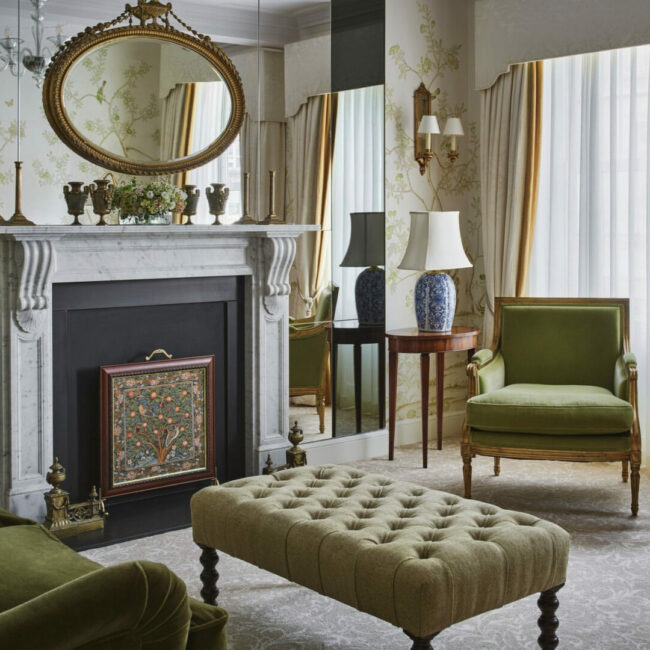
#3 What are the latest wallpaper trends?
When it comes to finding inspiration for your wallpaper and interior design projects, there are several excellent sources to explore:
Design Books: Design books, magazines, and catalogs can be great sources of inspiration. They often feature the latest trends, classic styles, and creative design ideas. These publications showcase a wide range of design concepts and can help you find the perfect wallpaper style for your space. Vogue.com recently wrote a review of the best books for interior design inspiration, which can be found here.
Pinterest: Pinterest is a popular platform for discovering and collecting design ideas. You can create boards and pin images of wallpaper styles, color schemes, and room layouts that resonate with your aesthetic. It’s a visual treasure trove of design inspiration, and you can explore various themes and styles to find what appeals to you.
Instagram: Instagram is another valuable resource, especially for real-world design inspiration. Many interior designers and architects share their work on Instagram, providing a glimpse into their creative processes and showcasing completed projects. You can follow these professionals to stay updated on the latest design trends and see how different wallpapers are used in actual homes.
While you can certainly educate yourself on the technical aspects of wallpaper installation and interior design, it’s often wise to seek guidance from interior designers and architects when it comes to anything creative or design-related. These experts bring a wealth of knowledge and experience to the table, helping you make informed decisions about colour, pattern, layout, and how to best achieve your desired aesthetic.
Regarding wallpaper styles, it’s true that certain design elements never go out of style, and Chinoiserie is a prime example of this. Chinoiserie is a classic and timeless design style inspired by Chinese art and culture. It typically features intricate and detailed illustrations of landscapes, birds, and floral motifs. Chinoiserie wallpapers have been popular for centuries and continue to be a sought-after choice in contemporary interior design.
The enduring appeal of Chinoiserie can be attributed to its versatility. It can be adapted to various design schemes, from traditional to modern, and it adds an element of sophistication and elegance to any space. Chinoiserie’s intricate patterns and rich history make it a reliable choice for those looking to create a timeless and visually captivating interior. Whether you use it as an accent or cover an entire room, Chinoiserie wallpaper is a design element that remains a classic choice in the world of interior design.
#4 Where to buy wallpaper?
Good question, and you are spoilt for choice. Wells are honoured to be recommended by some of the world’s leading wallcovering brands. They know they can trust us absolutely with their products, so any issues with installation can always be resolved swiftly and collaboratively. You’ve also got custom wallcoverings to consider. There are a lot of companies that offer it now; Fromental, de Gorunay, Zuber, Gracie, Iksel. They offer a custom-fit service. Just remember that they add to the lead time as they can take 12-weeks to produce. Check out our partners here.
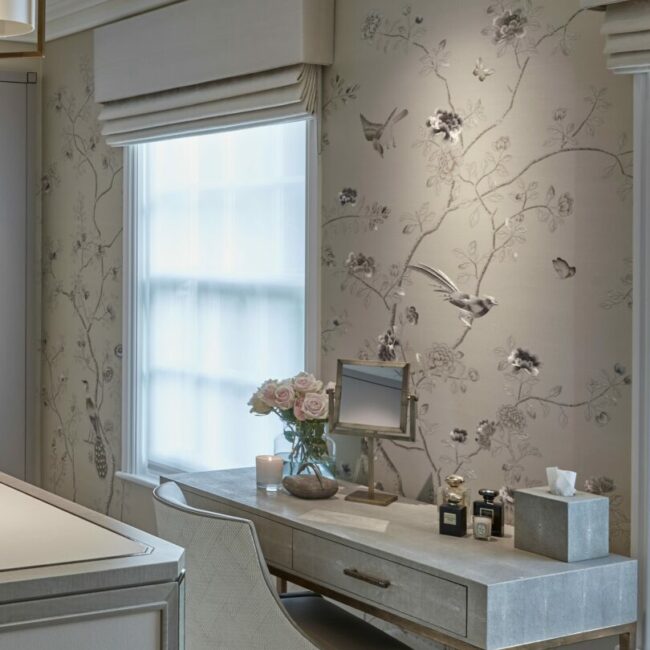
#5 How to calculate wallpaper needed for a room?
Quantifying wallpaper, or determining how much wallpaper you need for a particular project, is an important step in the wallpaper installation process. To quantify wallpaper, you need to measure the walls you intend to cover and consider the dimensions and design of the wallpaper. Here’s a general guide on how to quantify wallpaper:
Measure the Walls: Measure the height and width of each wall you plan to wallpaper. Measure from floor to ceiling and from corner to corner. Be precise in your measurements.
Calculate Square Footage: To calculate the square footage of each wall, multiply the height by the width. For example, if a wall is 8 feet high and 12 feet wide, the square footage would be 8 feet x 12 feet = 96 square feet.
Deduct for Openings: If there are windows, doors, or other openings on the wall, subtract their square footage from the total. Measure each opening separately and subtract those measurements from the total wall square footage.
Consider the Wallpaper Design: The design of the wallpaper can affect the amount you need. If the wallpaper has a pattern, you may need to account for matching the pattern at the seams, which can result in more waste.
Add Extra for Allowance: It’s a good practice to add extra wallpaper to your total to account for any mistakes, future repairs, or for matching patterns. Typically, adding 10-15% to your total square footage is a safe margin.
Check the Roll Size: Wallpaper is typically sold in rolls, and the roll size can vary. Check the label on the wallpaper you’re considering to see how many square feet it covers per roll.
Order Wallpaper: Once you have calculated the total square footage, you can order the appropriate number of rolls to cover your walls.
#6 Can you wallpaper over wallpaper?
Wallpapering over existing wallpaper is possible, and it can save time and money, but it’s not always the ideal approach, and there are several important considerations to keep in mind:
Condition of Existing Wallpaper: The condition of the existing wallpaper is crucial. If it’s securely adhered to the wall, has no tears, bubbles, or other visible defects, and has a smooth surface, it might be a candidate for wallpapering over.
Age of Existing Wallpaper: Knowing how long the current wallpaper has been in place is essential. Older wallpaper may be more challenging to work with, as adhesives can deteriorate over time, making it more likely to detach from the wall.
Type of Wallpaper: The type of wallpaper you’re working with matters. Vinyl wallpaper can be a better candidate for wallpapering over, as it provides a smoother and more stable surface than traditional paper wallpapers. However, it’s still important to evaluate the condition.
Adhesive Residue: If the existing wallpaper has been removed before, it might leave behind adhesive residue. This residue needs to be carefully cleaned and smoothed out to create a suitable surface for new wallpaper.
Risk of Bubbles and Adhesion Issues: The primary concern with wallpapering over wallpaper is that you don’t know how the original wallpaper will react to the new adhesive. There’s a risk of bubbles, poor adhesion, or the old wallpaper loosening over time.
Patterns and Textures: The pattern and texture of the existing wallpaper can affect the outcome. If the new wallpaper is thin or has a light color, it may not completely cover the pattern or color of the old wallpaper.
If you decide to wallpaper over existing wallpaper, here are some general steps to follow:
Clean and Repair: Ensure that the existing wallpaper is clean and in good condition. Repair any tears, bubbles, or loose areas.
Prime the Surface: Apply a wallpaper primer to create a smooth, even surface for the new wallpaper. This helps improve adhesion.
Test Adhesion: Before applying new wallpaper, test a small section to see how well it adheres to the existing wallpaper. This can help you assess the risk of potential issues.
Choose the Right Wallpaper: Select a new wallpaper that is suitable for wallpapering over existing wallpaper. Thicker wallpapers or those with a non-woven backing are often better choices.
Apply Wallpaper: Follow the manufacturer’s instructions for applying the new wallpaper. Take care to match patterns, seams, and ensure a smooth application.
While wallpapering over existing wallpaper can be done, it’s generally recommended to remove the old wallpaper and start with a clean, well-prepared wall surface for the best and most long-lasting results. If you’re uncertain about whether to wallpaper over existing wallpaper, consulting a professional wallpaper installer can provide valuable guidance.
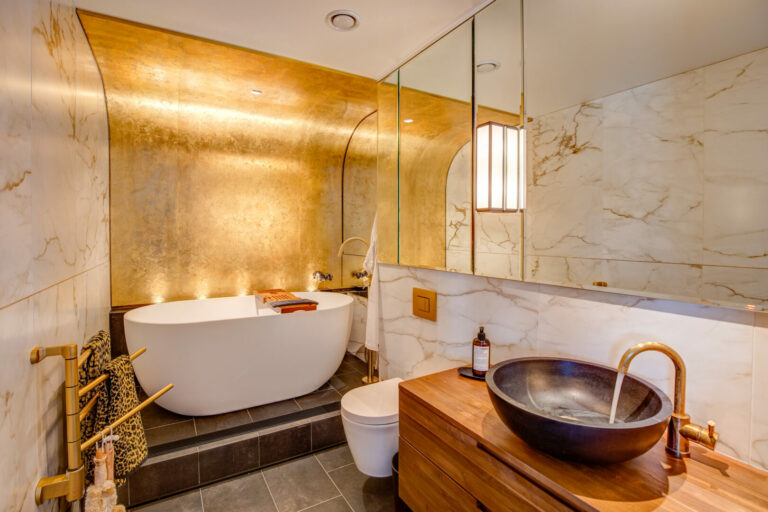
#7 What is the cost of professional wallpaper installation?
he cost of wallpaper installation can vary significantly, and there are numerous factors that contribute to the overall expense. Here are some of the key considerations that can affect the cost:
Location: Your geographic location plays a significant role in determining the cost of wallpaper installation. Labor and material costs can vary greatly from one region to another. Larger cities and more affluent areas may have higher labor costs.
Travel and Accommodation: If the job requires the installer to travel a considerable distance or stay overnight, travel and accommodation costs may be added to the total expenses.
Size of the Rooms: The size of the rooms being wallpapered will naturally impact the cost. Larger rooms require more wallpaper and more time for installation.
Complexity of the Job: If the job involves intricate or complex designs, patterns, or custom work, it will likely be more expensive. Matching patterns, creating custom designs, or working with specialty materials can increase labor costs.
Age and Heritage of the Building: Older and heritage buildings may present unique challenges. The condition of the walls, the presence of lead paint, or the need for repairs can add to the cost.
Wallcovering Material: The specific type of wallcovering you choose will have a significant impact on the cost. High-end materials, designer brands, or specialty wallcoverings can be more expensive.
Preparation Work: The condition of the walls before installation is a critical factor. If there are repairs or extensive preparation work required, such as wall priming or removing existing wallpaper, it can add to the overall cost.
Labor Costs: Labor costs are a major component of the total expense. The experience and skill level of the wallpaper installer can affect the labor cost, as more experienced professionals often charge higher rates.
Extras: Additional services, such as removal and disposal of old wallpaper, painting, or any necessary repairs, will add to the total cost.
Accessories and Tools: Special tools, adhesives, and accessories required for specific types of wallpaper may also increase the overall expense.
Permits and Regulations: In some cases, building permits or compliance with local regulations may be necessary, which can involve additional costs.
To get an accurate estimate for your wallpaper installation project, it’s recommended to obtain quotes from several professional installers in your area. They can assess the specific details of your project and provide a more precise cost estimate that takes into account the factors mentioned above. Keep in mind that while cost is an important consideration, it’s also essential to choose an experienced and reputable installer to ensure a high-quality result.
#8 How to clean wallpaper?
Different wallcoverings are made from various materials, including delicate fabrics, silks, grasscloth, and more. Understanding the specific material of your wallcovering is crucial, as it will dictate the handling and installation process.
Cleaning high-end and very expensive wallpaper requires special care to protect the delicate and often unique materials used in these wallcoverings. Here are some general guidelines for cleaning such wallpaper:
Dust Regularly: Regular dusting with a soft, clean, and dry microfiber cloth or a soft brush is the best preventive measure. Gently wipe away dust and dirt from the surface. Avoid using excessive pressure, as it may damage the wallpaper.
Vacuum with a Soft Brush Attachment: Use a vacuum cleaner with a soft brush attachment to remove dust from the wallpaper’s surface. Keep the vacuum on a low setting to prevent it from pulling at the wallpaper. Be sure not to let the vacuum nozzle touch the wallpaper directly.
Spot Cleaning: If you need to address specific stains or marks, start by testing a small, inconspicuous area of the wallpaper with a gentle cleaning solution. Use a mild, non-abrasive, and non-bleaching detergent or cleaning product specifically designed for delicate wallcoverings. Dilute the cleaning solution as directed.
Use a Soft Cloth or Sponge: Dampen a soft, lint-free cloth or sponge with the diluted cleaning solution. Wipe the stained area gently in a circular motion, working from the outside of the stain toward the center. Do not scrub vigorously, as it may damage the wallpaper.
Rinse with Clean Water: After spot cleaning, use a clean, damp cloth or sponge to rinse the area. Make sure you remove any residue from the cleaning solution. Dry the area by blotting with a dry cloth.
Avoid Excessive Moisture: Do not saturate the wallpaper with water. Excessive moisture can weaken the adhesive and cause the wallpaper to peel or lose its shape.
Consult the Manufacturer: For specific cleaning recommendations, refer to the manufacturer’s guidelines provided with the wallpaper. High-end wallpaper brands often offer detailed care instructions for their products. Following their advice is essential to preserve the quality of the wallpaper.
Professional Cleaning: In some cases, especially for very expensive and delicate wallpaper, it may be best to hire a professional wallpaper cleaning service with experience in handling high-end wallcoverings.
Preventative Measures: To minimize the need for cleaning, consider taking preventative measures like using a humidifier to maintain the right humidity level in the room, as excessive dryness can lead to dust accumulation and static electricity, which attracts dust.
Avoid Harsh Chemicals: Do not use abrasive or harsh cleaning chemicals, as they can damage the wallpaper. This includes products containing bleach, ammonia, or other strong chemicals.
Remember that the specific cleaning methods for high-end wallpaper can vary based on the material and finish of the wallcovering. Always refer to the manufacturer’s recommendations and guidelines for your specific wallpaper. When in doubt, consult a professional cleaner or installer experienced in handling delicate and expensive wallcoverings to ensure that the cleaning process is done correctly and safely.
#9 Where to find wallpaper design inspiration?
Have you been to the Design Centre in Chelsea Harbour? With all of the showrooms on offer, it is a sweet shop of inspiration. There are endless answers to this question, with inspiration coming from anywhere and everywhere. We recently sat in on a panel talk with Natalia Miyar and she was talking about how she finds books really useful, more so than Pinterest and Instagram.
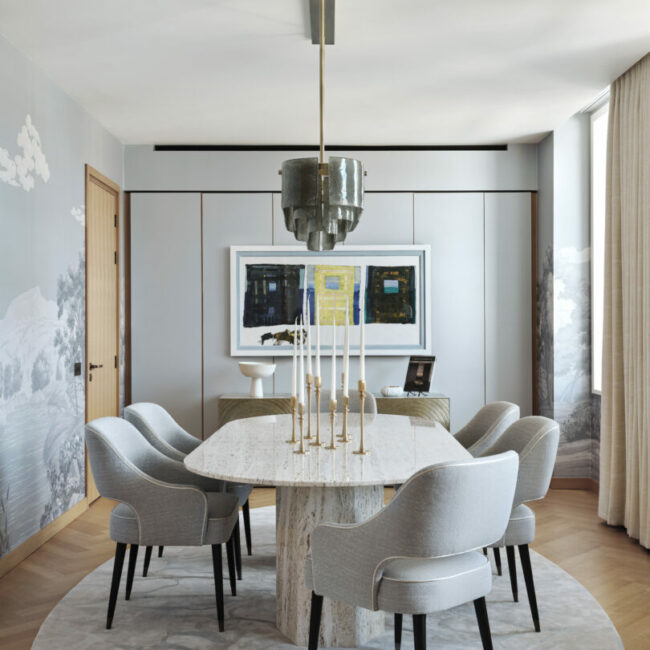
#10 How to choose the right wallpaper for a small space?”
Designing smaller spaces can be a unique and creative challenge. Here are some common issues that smaller spaces can present in interior design and tips for addressing them:
Limited Space: Smaller rooms have less square footage, which can make it challenging to fit all the necessary furniture and elements without making the space feel cramped.
- Tip: Opt for multi-functional furniture, such as a sofa bed or a fold-out dining table. Consider built-in storage solutions to maximize space. Choose furniture that is proportionate to the room’s size.
Lack of Natural Light: Smaller spaces may have limited access to natural light, making them feel dark and confined.
- Tip: Use light and reflective colors for walls, ceilings, and furniture to brighten the space. Install mirrors strategically to bounce light around the room. Consider sheer curtains or blinds to allow natural light in while maintaining privacy.
Clutter: Smaller spaces can quickly become cluttered, making the room feel even smaller.
- Tip: Regularly declutter the space and be selective about the decor and furniture you choose. Use storage solutions to keep items organized and out of sight.
Scale and Proportion: Choosing furniture and decor that are too large can overwhelm a small room, while items that are too small may make the space feel empty.
- Tip: Pay attention to scale and proportion. Select furniture that fits the room and leaves enough space to move around comfortably. Consider furniture with exposed legs to create a sense of openness.
Furniture Layout: Arranging furniture in a small space can be a puzzle. A poor layout can make the room feel awkward and inefficient.
- Tip: Experiment with different furniture layouts to find the most efficient and visually appealing arrangement. Consider placing furniture against the walls to free up floor space in the center.
Limited Storage: Smaller rooms often lack storage space, which can lead to a cluttered and disorganized look.
- Tip: Use vertical storage solutions like tall bookshelves and cabinets to maximize storage without taking up much floor space. Consider under-bed storage or wall-mounted storage options.
Monotony: Small spaces can sometimes feel monotonous if not designed thoughtfully.
- Tip: Add visual interest through color, texture, and pattern. Use an accent wall, bold color accents, or eye-catching decor to create focal points and break up the monotony.
Ceiling Height: In some smaller spaces, low ceilings can make the room feel even more confined.
- Tip: Use vertical stripes on walls, and avoid heavy, low-hanging light fixtures to give the illusion of higher ceilings. Paint the ceiling a lighter color than the walls to visually lift it.
Furnishing a Small Kitchen: Small kitchens can present challenges in terms of storage and workspace.
- Tip: Install open shelves to make the space feel more open, use compact appliances, and consider a kitchen island with storage to provide additional counter space.
Inadequate Seating: Finding comfortable seating for a small living room or dining area can be tricky.
- Tip: Consider modular or sectional sofas that can be configured to fit the space. Use space-saving dining tables and chairs that can be tucked away when not in use.
Small spaces require thoughtful planning and design to make the most of the available room while ensuring functionality and aesthetics. By addressing these common issues with creative solutions, you can transform a small space into a comfortable and visually appealing area.


